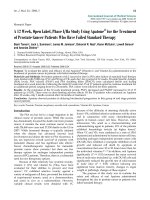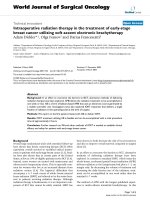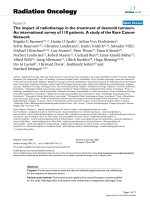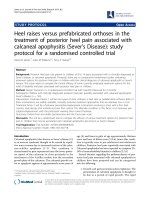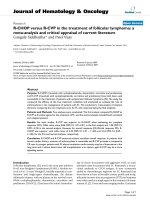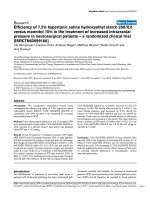A mobile application of breast cancer e-support program versus routine Care in the treatment of Chinese women with breast cancer undergoing chemotherapy: Study protocol for a randomized
Bạn đang xem bản rút gọn của tài liệu. Xem và tải ngay bản đầy đủ của tài liệu tại đây (674.76 KB, 9 trang )
Zhu et al. BMC Cancer (2017) 17:291
DOI 10.1186/s12885-017-3276-7
STUDY PROTOCOL
Open Access
A mobile application of breast cancer
e-support program versus routine Care in
the treatment of Chinese women with
breast cancer undergoing chemotherapy:
study protocol for a randomized
controlled trial
Jiemin Zhu1,2*, Lyn Ebert2, Xiangyu Liu3 and Sally Wai-Chi Chan2
Abstract
Background: Women with breast cancer undergoing chemotherapy suffer from a number of symptoms and report
receiving inadequate support from health care professionals. Innovative and easily accessible interventions are
lacking. Breast Cancer e-Support is a mobile Application program (App) that provides patients with individually
tailored information and a support group of peers and health care professionals. Breast Cancer e-Support aims to
promote women’s self-efficacy, social support and symptom management, thus improving their quality of life and
psychological well-being.
Methods: A single-blinded, multi-centre, randomised, 6-month, parallel-group superiority design will be used. Based
on Bandura’s self-efficacy theory and the social exchange theory, Breast Cancer e-Support has four modules: 1) a
Learning forum; 2) a Discussion forum; 3) an Ask-the-Expert forum; and 4) a Personal Stories forum. Women with
breast cancer (n = 108) who are commencing chemotherapy will be recruited from two university-affiliated
hospitals in China. They will be randomly assigned to either control group that receives routine care or intervention
group that receives routine care plus access to Breast Cancer e-Support program during their four cycles of
chemotherapy. Self-efficacy, social support, symptom distress, quality of life, and anxiety and depression will be
measured at baseline, then one week and 12 weeks post-intervention.
(Continued on next page)
* Correspondence:
1
Nursing Department, Medical College of Xiamen University, Xiangan Nan
road, Xiangan District, Xiamen city, Fujian Province 361102, People’s Republic
of China
2
School of Nursing and Midwifery, Faculty of Health and Medicine, University
of Newcastles, Richardson Wing, Callaghan University Drive, Callaghan, NSW
2308, Australia
Full list of author information is available at the end of the article
© The Author(s). 2017 Open Access This article is distributed under the terms of the Creative Commons Attribution 4.0
International License ( which permits unrestricted use, distribution, and
reproduction in any medium, provided you give appropriate credit to the original author(s) and the source, provide a link to
the Creative Commons license, and indicate if changes were made. The Creative Commons Public Domain Dedication waiver
( applies to the data made available in this article, unless otherwise stated.
Zhu et al. BMC Cancer (2017) 17:291
Page 2 of 9
(Continued from previous page)
Discussion: This is the first study of its kind in China to evaluate the use of a mobile application intervention with a
rigorous research design and theoretical framework. This study will contribute to evidence regarding the effectiveness
of a theory-based mobile application to support women with breast cancer undergoing chemotherapy. The results
should provide a better understanding of the role of self-efficacy and social support in reducing symptom
distress and of the credibility of using a theoretical framework to develop internet-based interventions.
The results will provide evidence to support the implementation of an innovative and easily accessible
intervention that enhances health outcomes.
Trial registration: ACTRN: ACTRN12616000639426, Registered 17 May, 2016.
Keywords: Breast cancer, Chemotherapy, Internet, Self-efficacy, Social support, Symptom distress, Quality of
life, Psychological well-being
Background
Breast cancer is a major global public health problem. In
China, breast cancer is growing as the most common
cancer and the 6th leading cause of cancer-related death
among women [1]. Adjuvant chemotherapy is a common
treatment for invasive breast cancer in China, with approximately 81.4% of these women receiving chemotherapy [2]. The physical and psychological symptoms that
occur after diagnosis and during chemotherapy can have a
negative impact on the women’s quality of life (QoL) and
psychological well-being [3]. Symptom management is
therefore beneficial for women with breast cancer [4, 5],
and reduced symptom distress is a crucial outcome of
successful psychosocial interventions [6]. Symptom management requires that women understand appropriate
management strategies and have appropriate levels of selfefficacy and social support to apply such strategies [7].
Evidence suggests that Chinese women with breast
cancer receive inadequate support from health care professionals [8]. The increasing number of women with
breast cancer [1], the insufficient financial commitment
to health care from the government (5.5% of the GDP)
[9, 10], and the shortage of oncology specialists [9] pose
challenges to the feasibility of traditional face-to-face interventions. Internet-based interactive programs (IIPs)
that enable health care professionals and patients to
interact with each other via the internet to transmit
health information and to offer and accept support can
provide an innovative and easily accessible approach that
can reach large groups of patients [11, 12].
Although preliminary evidence suggests that IIPs have
had a positive impact in facilitating symptom management among women with breast cancer in Norway and
the United States [6, 13], there is a worldwide paucity of
rigorous trials that have evaluated the effectiveness of
internet-based interventions for women with breast
cancer [14]. In mainland China, there has been only
limited investigation of the effectiveness of IIPs among
Chinese women with breast cancer. Two such studies,
published in Chinese, reported that IIPs improved
symptom distress and self-efficacy [15] and decreased
depression among women with breast cancer [16]. These
two studies on IIPs in the Chinese population showed
that the internet could be a useful tool for educating
women about breast cancer. However, these two studies
were not performed using randomised controlled trials
(RCT). To the best of our knowledge, no RCTs have
been conducted in Mainland China that evaluate the effects of an IIP for women with breast cancer undergoing
chemotherapy.
In 2015, 50.3% of China’s population frequently used
the internet [17], and 88.9% of these people access the
internet by mobile devices [18]. With more women turning to mobile phone to search for information, mobile
Applications (Apps) could provide a promising platform
to apply IIP for women with breast cancer. However, a
review of smartphone breast Apps reported the lack of
evidence base and medical professional involvement in
their development [19]. To improve women’s confidence
in the use of Apps and further promote the implementation in health service, Mobasheri et al. [19] recommended
that a robust framework, full authorship disclosure, and
high quality clinical trials are needed to develop and test
the effectiveness of Apps for women with breast cancer.
The breast cancer e-support program (BCS)
The Breast Cancer e-Support program (BCS) is a mobile
IIP application (App) for Chinese women with breast
cancer who are undergoing chemotherapy. The BCS was
developed using the theoretical framework [20], which
incorporate Bandura’s self-efficacy theory [21] and the
social exchange theory [22]. Appropriate levels of selfefficacy and social support are essential components of
interventions to improve patients’ symptom management [23]. The BCS aims to enhance women’s selfefficacy and social support to promote their ability to
manage the symptoms associated with breast cancer
diagnosis and chemotherapy, thus improving their QoL
and psychological well-being.
Zhu et al. BMC Cancer (2017) 17:291
Page 3 of 9
Self-efficacy, an individual’s perception of her ability to
act effectively in a given situation, plays a crucial role in
influencing a woman’s ability to manage her symptoms
[21]. Self-efficacy comprises four main factors: direct
mastery experiences, vicarious experiences, verbal persuasion and arousal state [21]. Direct mastery experiences involve previous personal accomplishments and
successes. Vicarious experiences are gained by watching
others achieve success in similar situations. Verbal
persuasion comes from feedback and verbal cues from
others. Finally, arousal states are defined as a person’s
physiological state and their perception of that state.
Social support is defined as a combination of structural
support and functional support [22]. Structural support
consists of formal support from health care professionals
and informal support from significant others. Functional
support consists of exchange activities that take place
among individuals, including emotional, instrumental, informational, and appraisal support. Access to a variety of
types of functional support from different care providers,
both health care professionals and significant others, is
important for coping with stress [22].
The BCS program is a multi-component intervention
that includes a Learning forum, a Discussion forum, an
Ask-the-Expert forum, and a Personal Stories forum.
Four factors from the self-efficacy theory [21] and the
functional and structural social support concepts from
the social exchange theory [22] are incorporated into the
BCS program. Regarding the self-efficacy theory, mastery
experiences include the provision of symptom management knowledge in the Learning forum; vicarious experiences involve reading others’ personal stories in the
Personal Stories forum and sharing experiences in the
Discussion forum; verbal persuasion comes from feedback and verbal cues from peers and health care professionals in the Discussion forum and Ask-the-Expert
forum; and the learning materials and sharing of experiences may modify women’s perceptions of their expected
arousal states. In terms of social exchange theory, the
Functional
Support
Structural
Support
Personal
Mastery
Experience
Discussion and Ask-the-Expert forums are designed to
build structural social networks and provide multiple
types of functional support from peers and health care
professionals. Figure 1 illustrates the theoretical framework of the BCS.
Objectives
The objective of this RCT is to evaluate the effectiveness
of the BCS program for Chinese women with breast
cancer undergoing chemotherapy in terms of enhancing
the women’s self-efficacy, social support and QoL, and
reducing their symptom distress, anxiety and depression.
We hypothesise that compared with the control group
at baseline, post-test 1 and post-test 2, the women with
breast cancer who are undergoing chemotherapy in the
experimental group will have the following significant
differences:
1. Improved self-efficacy, social support and QoL;
2. Reduced symptom distress, anxiety and depression;
and
3. Greater satisfaction with the health care received
during chemotherapy.
Trial design
A single-blinded, multicentre, randomised, controlled,
parallel-group pre-test and repeated post-test superiority
design will be used to investigate the effect of the BCS
program for women with breast cancer who are undergoing chemotherapy.
Methods
The study follows the SPIRIT 2013 Statement and the
guidelines for the Standard Protocol of Clinical Trials
[24, 25]. The study received ethic approval from the
University of Newcastle in Australia and the two participating hospitals in P. R. China. The registration number
with the Australian New Zealand Clinical Trials Registry
is ACTRN12616000639426.
Vicarious
Experience
Verbal
Persuasion
Physical/
Affective
State
Cancer Patients’
Self-Efficacy
Social
Support
Breast Cancer e-Support
Symptom Distress
Quality of Life
Anxiety and Depression
Fig. 1 Theoretical framework of the Breast Cancer e-Support Program - adapted from Shorey et al. [21]
Zhu et al. BMC Cancer (2017) 17:291
Study setting
This study will be conducted in two university affiliated
tertiary public hospitals in the People’s Republic of
China. At each participating hospital, an average of 40
women with breast cancer per month receive chemotherapy; approximately 15 of these women have access
to the internet. The usual treatment for women with
breast cancer at these two participating hospital consists
of four cycles of chemotherapy, with each cycle lasting
21 days.
Eligibility criteria
Participants will be recruited on the day they commence
chemotherapy. The inclusion criteria will be: (1) at least
18 years of age; (2) diagnosed with breast cancer within
the past 3–8 weeks; (3) treated with chemotherapy at
the study sites; (4) able to access the internet with a
mobile phone; (5) cognitively and physically capable of
participating and completing self-report questionnaires;
(6) contactable via telephone or email for follow up; and
(7) able to speak and read Mandarin. The exclusion criteria for women will be: (1) having a concurrent major
physical illness and (2) having a chronic mental health
problem.
Intervention
BCS program
A research team at the School of Nursing and Midwifery
at the University of Newcastle, Australia, developed the
intervention, with technical assistance from the Suncco
Internet Company in the People’s Republic of China.
The BCS program is supported by the National Natural
Science Foundation of China (71503219).
The Breast Cancer e-Support (BCS) program has a
fixed structure that covers four cycles of chemotherapy,
which last approximately 12 weeks. Data from previous
studies suggest that IIPs provide the greatest benefits to
women that have recently been diagnosed with breast
cancer and are in the early stages of treatment [26], and
that an 8-week online intervention is enough to produce
changes in psychological outcomes [27]. Thus, a 12-week
intervention is considered sufficient to test the effectiveness of the BCS. A pamphlet has been developed to provide guidance for downloading the BCS program from the
website and navigating
the various sites within the BCS. It is up to the women to
decide how often they access the BCS and how long they
use the intervention.
The BCS has four modules: 1) a Learning forum; 2) a
Discussion forum; 3) an Ask-the-Expert forum; and 4) a
Personal Stories forum. These four modules are visually
recognisable on the homepage of the BCS (see Fig. 2). The
Learning forum provides 15 topics on symptoms management, including 1) nausea and vomiting management; 2)
Page 4 of 9
improving diet by making healthier food choices; 3)
exercise and recovery; 4) how to deal with hand-foot
syndrome; 5) how to deal with upper limber lymphoedema; 6) infection prevention and management; 7) fatigue
management; 8) how to deal with depression and anxiety;
9) alopecia management; 10) oral mucositis management;
11) constipation management; 12) sleep management; 13)
diarrhoea management; 14) how to deal with body
changes; 15) bleeding and anaemia management. To
create the 15 topics, detailed discussions with multidisciplinary Chinese oncology professionals were carried out.
The Learning forum also provides basic information about
breast cancer symptoms, diagnosis, stages, treatment
options and community support service.
The Discussion forum and the Ask-the-Expert forum
provide opportunities for social networking. In the
Discussion forum, women will be invited to discuss
symptom management topics and to share information
and experience. In the Ask-the-Expert forum, health
care professionals (a doctor and a senior nurse) will respond to health-related questions posed by individuals
within 24 h. Only the individual that posed the question
and the health care professionals will have access to the
question and to the response. In the Personal stories
forum, five recorded interviews with women who
completed chemotherapy after breast cancer diagnosis
and surgery will be available. Women with different stages
of breast cancer, different ages, and different socioeconomic statuses will be interviewed and recorded to
provide role models for women with different needs. The
moderator, an experienced health care professional, will
moderate the online forum by reading all messages daily,
facilitating online discussions, providing expert information when requested, and intervening appropriately if the
messages posted are inappropriate or hostile.
Privacy
A member of the research team will help the women in
the intervention group to register with the BCS program.
The women will be initially assigned their mobile phone
number as the user name; however, they can change their
user names later by themselves. The women will submit
their applications to the BCS program. Once the researcher approves applications through the App background management system, they women will set their
own passwords. The user name will expire 12 weeks after
activation. The participants will be informed that the
researcher can access their profile.
Support
The researcher will offer personal training (averaging
30 min) to the experimental group to help its members
download and install the App onto their mobile phones,
demonstrate the usage of each module of the BCS, and
Zhu et al. BMC Cancer (2017) 17:291
Page 5 of 9
Home Page
Learning Forum
Discussion Forum
Ask-the-Expert Forum
Personal Story Forum
Fig. 2 Screenshots of the BCS program home page and the four modules
help the women write an introductory message in the
Discussion forum and ask a question in the Ask-theExpert forum.
Technical assistance will be available via email or telephone from 8:00 am to 5:00 pm from Monday to Friday.
At other times, users can email a technical assistant or
leave a message on voicemail. A technical assistant will
check emails and voicemail messages five days a week
and respond to the women as soon as possible.
the women’s adherence to the intervention. To maintain
consistency in the delivery of the intervention, the same
researcher (ZJM) will organise the topics, give feedback
and verbal cues, and provide encouragement and
suggestions in the Discussion forum to the women regarding their progress with symptom management. The
frequency and duration of the logins will be monitored
to evaluate the women’s adherence. The women’s questions will be answered by health care professionals
within 24 h to improve adherence to the BCS program.
Fidelity of the intervention
Different strategies will be used to enhance the fidelity
of the BCS, such as maintaining consistency in the delivery of the intervention and monitoring and reinforcing
Comparison
The women in both the experimental and control
groups will receive routine care provided by the hospital.
Zhu et al. BMC Cancer (2017) 17:291
Routine care involves support from doctors and nurses
during the two-day hospitalisation for each cycle of
chemotherapy. Before treatment commences, a nurse
will provide information on chemotherapy and possible
side effects. There are currently no IIPs for education
and social support provided by health care services at
the study sites. The control group may freely use the
internet to search for information about breast cancer.
However, they will not have access to the BCS program.
Outcome measures
Primary outcomes
Stanford Inventory of Cancer Patient Adjustment
(SICPA) Self-efficacy will be measured using the Stanford
Inventory of Cancer Patient Adjustment (SICPA) [28].
The SICPA is a 38-item instrument assessing patients’ beliefs in their ability to manage cancer-related problems.
Higher total scores equate to a higher level of self-efficacy.
The SICPA has demonstrated good psychometric properties [28]. The SICPA has been translated into Chinese and
validated in patients with cancer. The Chinese version of
the SICPA has Cronbach’s alpha reliability coefficients of
0.95 [29].
Multidimensional Scale of Perceived Social Support
(MSPSS) Social support will be evaluated using the
Multidimensional Scale of Perceived Social Support
(MSPSS) [30]. The MSPSS is a 12-item self-report instrument assessing the respondent’s perceptions of support
from three sources: family, friends and a significant other.
A mean score greater than 5 indicates good support, a
score of 3 to 5 indicates moderate support, and a score of
less than 3 indicates poor social support. The original
MSPSS has good reliability and validity [30]. The MSPSS
has been translated into Chinese and validated in a
Chinese population. The Chinese version of the MSPSS
has adequate internal consistency (Cronbach’s α = 0.92)
and construct validity [31].
Secondary outcomes
M.D. Anderson symptom Inventory (MDASI)
Symptom distress will be assessed using the M.D.
Anderson Symptom Inventory (MDASI) [32]. The
MDASI consists of a 13-item symptom scale and a 6item interference scale. A mean score of 1 to 4 indicates
mild symptom distress, 5–6 indicates moderate symptom distress, and 7–10 indicates severe symptom
distress. The original MDASI has demonstrated good
reliability and validity [32]. The MDASI has been translated into Chinese and used in Chinese patients with
cancer. The Chinese version of the MDASI has
Cronbach’s alpha reliability coefficients of 0.74 and 0.88
for the symptom subscale and interference subscale,
respectively [29].
Page 6 of 9
Functional Assessment of cancer treatment-B (FACT-B,
version 4)
Quality of life related to breast cancer will be measured
using a Chinese version of the Functional Assessment of
Cancer Treatment-B (FACT-B) [33]. FACT-B is a 37item instrument assessing the impact of breast cancer
and chemotherapy on dimensions of QoL. A higher total
score means a better QoL. The English version of
FACT-B has demonstrated good reliability and validity
for women with breast cancer [34]. FACT-B has been
translated into Chinese and has been widely used to
assess the QoL of Chinese patients with different types
of cancer. The Chinese version of FACT-B has a Cronbach’s alpha reliability coefficient of 0.87 for the entire
scale [35].
Hospital anxiety and depression scale (HADS)
Anxiety and depression will be assessed using the
Hospital Anxiety and Depression Scale (HADS) [36].
The HADS is a 14-item instrument assessing depression
and anxiety in a medical setting. Higher total scores indicate greater distress. The original HADS has shown
good reliability and validity in breast cancer survivors
[37]. The HADS has been translated into Chinese and is
widely used in the Chinese population with different
types of health conditions. The Cronbach’s alpha coefficients of the Chinese version of HADS are 0.806 and
0.724 for the anxiety and depression subscales, respectively [3].
Other outcomes
Satisfaction with care
Women’s satisfaction with their care during chemotherapy
will be assessed with a six-item checklist developed for
this study. Questions such as “Overall, how satisfied are
you with the care so far?” will be rated on a five-point
Likert scale, with 1 meaning “not at all” and 5 meaning
“very much”. For each subscale, higher scores indicate
greater satisfaction (Additional file 1).
Internet usage data for the BCS
The website contains a tracking system. Internet usage
data, such as the frequency and duration of logins and
the website activity of each module of the BCS, will be
recorded and evaluated.
Demographic and clinical data
The data collected will include the women’s age, marital
status, highest education level, employment status,
monthly family income and BMI. Disease-related information will be provided by the hospital when the women
are recruited; such information will include breast
cancer stage, types of surgery, comorbidities and postoperative complications.
Zhu et al. BMC Cancer (2017) 17:291
Page 7 of 9
Participant timeline
Recruitment
This study began recruiting participants in May 2016,
and the primary endpoints (baseline and post-test 1) and
follow-up measure (post-test 2) are expected to be completed in February 2017. The Consolidated Standards of
Reporting Trials (CONSORT) flowchart is presented in
Fig. 3 [38].
Recruitment will take place before the women begin
chemotherapy. The physician will introduce the BCS to
women who meet the inclusion criteria and will provide
the women with the contact details of the research assistant (RA). Women that have contacted the RA will be
approached by the RA at the oncology unit to provide
them with additional information regarding the BCS and
to answer any questions that they might have. Women
who verbally agree to participate will be followed up to
obtain their written consent. The enrolment period is
expected to extend over a 6-month period. Data will be
collected before randomisation (baseline), immediately
after the intervention (post-test 1), and 12 weeks after
the intervention (post-test 2). The women will be
rewarded with a small gift (equal to RMB 30) for each
questionnaire completed.
Sample size
The primary outcome of self-efficacy will be used to
estimate the effect size based on power analysis [39]. A
previous study on IIPs for women with breast cancer
that measured QoL, social support, and health competence reported a medium effect size (0.46); however, the
effect size for self-efficacy was not mentioned [40].
Similar research on psychoeducation to enhance the
self-efficacy of Chinese patients with colorectal cancer
also demonstrated a medium effect size of 0.60 for selfefficacy [29]. We estimate a 20% attrition rate based on
a dropout rate of 10–15% in previous studies involving
IIPs [27, 40]. To achieve a power of 0.80 at a 0.05 level
of significance, a minimum of 108 women (54 in each
group) are required for this study.
Randomisation
For each hospital, the Research Randomizer [41] will be
used to generate a random set of 27 unique, nonduplicating numbers from 1 to 54. Different coloured
slips (pinks slips for randomly generated numbers, white
Enrolment
Eligibility screening (n=…)
Informed consent (n=…)
Baseline assessment (n=108)
Demographic data, SICPA, MSPSS, MDASI, FACT-B, HADS
Allocation
Randomisation
Allocated to intervention group (n=54):
BCS + routine care (12 weeks)
Allocated to control group (n=54):
Routine care (12 weeks)
Outcome measurement immediately after intervention (Post-test 1)
Follow-up
SICPA, MSPSS, MDASI, FACT-B, HADS
Lost to follow-up (give reasons)
Lost to follow-up (give reasons)
Outcome measurement 12 weeks after intervention (Post-test 2)
Analysis
SICPA, MSPSS, MDASI, FACT-B, HADS,
Internet usage data for the BCS, satisfaction with care
Intention-to-treat analysis (n=54)
Intention-to-treat analysis (n=54)
Fig. 3 CONSORT flowchart of the study - adapted from Schulz et al. [38]. Note: SICPA: Stanford Inventory of Cancer Patient Adjustment; MSPSS:
Multidimensional Scale of Perceived Social Support; MDASI: M.D. Anderson Symptom Inventory; FACT-B: Functional Assessment of Cancer
Treatment-B; HADS: Hospital Anxiety and Depression Scale
Zhu et al. BMC Cancer (2017) 17:291
slips for all other numbers) will be put into an opaque
envelope. The participants that pick a pink slip from the
opaque envelope will be assigned to the experimental
group; the others will be assigned to the control group.
The women in the intervention group will have access
to the BCS program and receive routine care while
undergoing treatment. The women in the control group
will receive routine care during treatment. The health
care providers and the RA collecting the data will be
blinded to the participants’ group allocation.
Data analysis
All outcome measures will be analysed using IBM SPSS
Statistics 21.0 [42]. An intention-to-treat analysis will be
adopted to manage missing data. The baseline differences between the intervention and control groups will
be assessed using the chi-square (χ2) test for binary
demographic data and the independent sample t-test for
continuous variables. Adjusted for possible confounding
factors of demographic variables, the repeated measures
triply MANCOVA will be conducted to determine
whether the BCS intervention is effective in improving
self-efficacy, social support and QoL and for reducing
symptom distress, anxiety and depression across three
time points of data collection (baseline, post-test 1 and
post-test 2). The independent t-test will be used to
compare how satisfied the experimental group and the
control group are with the care that they received during
chemotherapy 12 weeks after intervention.
Ethics, consent and permissions
The ethics approval for this study has been obtained from
the Human Research Ethics Officer at the University and
the participating hospitals. This study will adhere to
ethical standards for the whole procedure. Women will
not be deprived of any treatment and routine care, and
there is no potential rick or harm by participating in this
program. Women will be assured that participation in this
study is voluntary and they can withdraw from the study
at any point of time without any effect on their treatment.
The consent form will be obtained and all data will be
kept confidential and anonymous.
Discussion
This study will contribute to evidence on the effectiveness of using a theory-based BCS program to support
women as they cope with the unique challenges of
breast cancer and chemotherapy. The results of this
study will provide a better understanding of the role of
self-efficacy and social support in reducing symptom
distress and the credibility of using a theoretical framework to develop a BCS intervention. Such knowledge
may help to advance research regarding the use of
internet-based interactive methods to promote women’s
Page 8 of 9
symptom self-management, thus improving women’s
QoL and psychological well-being.
If the BCS program is effective, it could be offered by
health care professionals as part of the routine treatment
to enhance health outcomes for women with breast
cancer who are undergoing treatment in China. The
knowledge gained from this study could be used to plan
a culturally appropriate BCS program for other cancer
patients. If the BCS program is effective, this study will
provide evidence to support the need to train staff in ehealth and to allocate resources for developing e-health
to further advance this effort. To the best of the
researchers’ knowledge, this is the first study of its kind
that evaluates a BCS intervention using a rigorous
research design and a theoretical framework in China.
Additional file
Additional file 1: Satisfaction Evaluation Questionnaire. (DOCX 23 kb)
Abbreviations
APP: Mobile application; BCS: Breast Cancer e-Support; FACT-B: Functional
Assessment of Cancer Treatment-B; HADS: Hospital Anxiety and Depression
Scale; MDASI: M.D. Anderson Symptom Inventory; MSPSS: Multidimensional
Scale of Perceived Social Support; RA: Research assistant; RCT: Randomised
controlled trial; SICPA: Stanford Inventory of Cancer Patient Adjustment
Acknowledgements
Participating hospitals: Zhongshan Hospital (the affiliated hospital of Xiamen
University) and Hunan Cancer Hospital (the affiliated cancer hospital of
Xiangya School of Medicine, Central South University).
Funding
We acknowledge support from the National Natural Science Foundation of
China (71503219). The funding body provided the funding to develop the
web-based intervention of the study. The funding body had no influence on
the design of the study, content of the web, data collection, analysis and
interpretation of the data and in writing the manuscript.
Availability of data and materials
The datasets generated during the current study are not publicly available due
to the policy of the Human Ethics Committee, the University of Newcastle,
Australia, but are available from the corresponding author on reasonable request.
Authors’ contributions
JZ is a PhD student and is responsible for the literature review, patient
recruitment, data collection, data analysis and manuscript preparation. LE is
responsible for the study design, data analysis and manuscript preparation. XL is
responsible for patient recruitment, data collection and data analysis. SC
developed the original idea and is responsible for the study design, data analysis
and manuscript preparation. For the grant, JZ is the principal investigator; SC and
LE are co-investigators. All authors read and approved the final manuscript.
Competing interests
The authors declare that they have no competing interests.
Consent for publication
Not applicable.
Ethics approval and consent to participate
This study was approved by the ethic committee of University of Newcastle,
Australia (H-2015-0448), Xiamen University Affiliated Zhongshan Hospital
(20151023), and Xiangya Medical School of Central South University Affiliated
Hunan Cancer Hospital (20151026). Written informed consents from all the
participants were obtained.
Zhu et al. BMC Cancer (2017) 17:291
Author details
1
Nursing Department, Medical College of Xiamen University, Xiangan Nan
road, Xiangan District, Xiamen city, Fujian Province 361102, People’s Republic
of China. 2School of Nursing and Midwifery, Faculty of Health and Medicine,
University of Newcastles, Richardson Wing, Callaghan University Drive,
Callaghan, NSW 2308, Australia. 3Hunan Cancer Hospital, the affiliated cancer
hospital of Xiangya School of Medicine, Central South University, 283
Tongzipo Road, Yuelu District, Changsha, Hunan 410013, People’s Republic of
China.
Received: 30 July 2016 Accepted: 11 April 2017
References
1. Ferlay J, Shin HR, Bray F, Forman D, Mathers C, Parkin DM. Cancer incidence
and mortality worldwide: IARC CancerBase no.10. GLOBOCAN 2008.
International Agency for Research on Cancer: Lyon; 2010.
2. Fan L, Strasser-Weippl K, Li J-J, St Louis J, Finkelstein DM, Yu K-D, et al.
Breast cancer in China. Lancet Oncol. 2014;15:e279–e89.
3. So WKW, Marsh G, Ling WM, Leung FY, Lo JCK, Yeung M, et al. Anxiety,
depression and quality of life among Chinese breast cancer patients during
adjuvant therapy. Eur J Oncol Nurs. 2010;14:17–22.
4. Loh SY, Packer T, Chinna K, Quek KF. Effectiveness of a patient selfmanagement programme for breast cancer as a chronic illness: a nonrandomised controlled clinical trial. J Cancer Surviv. 2013;7:331–42.
5. Gaston-Johansson F, Fall-Dickson JM, Nanda JP, Sarenmalm EK, Browall M,
Goldstein N. Long-term effect of the self-management comprehensive
coping strategy program on quality of life in patients with breast cancer
treated with high-dose chemotherapy. Psychooncology. 2013;22:530–9.
6. Ruland CM, Andersen T, Jeneson A, Moore S, Grimsbø GH, Børøsund E, et al.
Effects of an internet support system to assist cancer patients in reducing
symptom distress: a randomized controlled trial. Cancer Nurs. 2013;36:6–17.
7. Sherman KA, Heard G, Cavanagh KL. Psychological effects and mediators of
a group multi-component program for breast cancer survivors. J Behav
Med. 2010;33:378–91.
8. Cheng HL, Sit JWH, Chan CWH, So WKW, Choi KC, Cheng KKF. Social
support and quality of life among Chinese breast cancer survivors: findings
from a mixed methods study. Eur J Oncol Nurs. 2013;17:788–96.
9. Goss PE, Strasser-Weippl K, Lee-Bychkovsky BL, Fan L, Li J, Chavarri-Guerra Y,
et al. Challenges to effective cancer control in China, India, and Russia.
Lancet Oncol. 2014;15:489–538.
10. Health expenditure per capita (current us$). The World Bank. 2017. http://
data.worldbank.org/indicator/SH.XPD.PCAP/countries?display=default.
Accessed 20 Feb 2017.
11. Murray E, Burns J, See Tai S, Lai R, Nazareth I. Interactive Health
Communication Applications for people with chronic disease. Cochrane
Database Syst Rev(4). 2005:CD004274.
12. van den Berg SW, Gielissen MF, Ottevanger PB, Prins JB. Rationale of the
BREAst cancer e-healTH [BREATH] multicentre randomised controlled trial:
an internet-based self-management intervention to foster adjustment after
curative breast cancer by decreasing distress and increasing empowerment.
BMC Cancer. 2012;12:394.
13. Wheelock AE, Bock MA, Martin EL, Hwang J, Ernest ML, Rugo HS, et al. SIS.
NET: A randomized controlled trial evaluating a web-based system for
symptom management after treatment of breast cancer. Cancer.
2015; 121:893–9.
14. Zhu JM, Ebert L, Chan WC. Integrative review: the effectiveness of internetbased interactive programs for women with breast cancer undergoing
treatment. Oncol Nurs Forum. 2017;44:E42–54.
15. Wang Y, Li N, Sun Y, Song H, Yang L, Wang Y, et al. The application of
mobile phone based symptom management system on breast cancer
patients undergoing transitional care with chemotherapy (article in
Chinese). Tijian J Nurs. 2015;1:6–8.
16. Huang X, Hu Y, Lu Z, Huang J, Shen K. Effect of an internet-based support
program on depression and disease-related knowledge in breast cancer
patients (article in Chinese). J Nurs Sci. 2011;2:1–4.
17. Internet users (per 100 people). The World Bank. 2017. http://data.
worldbank.org/indicator/IT.NET.USER.P2. Accessed 2 Feb 2017.
18. The Internet users and mobile phone users in China. China Internt Network
Information Center. 2017. />Accessed 2 Feb 2017 .
Page 9 of 9
19. Mobasheri MH, Johnston M, King D, Leff D, Thiruchelvam P, Darzi A.
Smartphone breast applications -What's the evidence? Breast.
2014;23(5):683–9.
20. Shorey S, Chan WCS, Chong YS, He HG. A randomized controlled trial of the
effectiveness of a postnatal psychoeducation programme on outcomes of
primiparas: study protocol. J Adv Nurs. 2015;71:193–203.
21. Bandura A. Self-efficacy: the exercise of control. New York: Freeman; 1997.
22. House JS. Work, stress & social support. NY: Addison-Wesley, Reading,
MA; 1981.
23. Grey M, Knafl K, McCorkle R. A framework for the study of self- and family
management of chronic conditions. Nurs Outlook. 2006;54:278–86.
24. Chan AW, Tetzlaff JM, Altman DG, Laupacis A, Gøtzsche PC, Krleza-Jeric K, et
al. SPIRIT 2013 statement: defining standard protocol items for clinical trials.
Ann Intern Med. 2013;158:200–8.
25. Chan A-W, Tetzlaff JM, Gøtzsche PC, Altman DG, Mann H, Berlin JA, et al.
SPIRIT 2013 explanation and elaboration: guidance for protocols of clinical
trials. BMJ. 2013;346:e7586.
26. Baker TB, Hawkins R, Pingree S, Roberts LJ, McDowell HE, Shaw BR, et al.
Optimizing eHealth breast cancer interventions: which types of eHealth
services are effective? Transl behav med. 2011;1:134–45.
27. Loiselle CG, Edgar L, Batist G, Lu J, Lauzier S. The impact of a multimedia
informational intervention on psychosocial adjustment among individuals
with newly diagnosed breast or prostate cancer: a feasibility study. Patient
Educ Couns. 2010;80:48–55.
28. Telch C: A comparison of Coping Skills Instruction and Support Group
Counseling in Alleviating Psychological Distress Among Cancer Patients.
(Unpublished doctoral dissertation). Stanford University; 1985.
29. Zhang M, Chan SW-C, You L, Wen Y, Peng L, Liu W, et al. The effectiveness
of a self-efficacy-enhancing intervention for Chinese patients with colorectal
cancer: a randomized controlled trial with 6-month follow up. Int J Nurs
Stud. 2014;51:1083–92.
30. Zimet GD, Dahlem NW, Zimet SG, Farley GK. The multidimensional scale of
perceived social support. J Pers Assess. 1988;52:30–41.
31. Zhou K, Li H, Wei X, Yin J, Liang P, Zhang H, et al. Reliability and validity of
the multidimensional scale of perceived social support in Chinese mainland
patients with methadone maintenance treatment. Compr Psychiatry.
2015;60:182–8.
32. Cleeland CS, Mendoza TR, Wang XS, Chou C, Harle MT, Morrissey M, et al.
Assessing symptom distress in cancer patients. Cancer. 2000;89:1634–46.
33. Brady MJ, Cella DF, Mo F, Bonomi AE, Tulsky DS, Lloyd SR, et al. Reliability
and validity of the functional Assessment of cancer therapy-breast
quality-of-life instrument. J Clin Oncol. 1997;15:974–86.
34. Cella DF, Tulsky DS, Gray G, Sarafian B, Linn E, Bonomi A, et al. The
functional Assessment of cancer therapy scale: development and validation
of the general measure. J Clin Oncol. 1993;11:570–9.
35. Ng R, Lee CF, Wong NS, Luo N, Yap YS, Lo SK, et al. Measurement
properties of the English and Chinese versions of the functional Assessment
of cancer therapy—breast (FACT-B) in Asian breast cancer patients.
Breast Cancer Res Treat. 2012;131:619–25.
36. Zigmond AS, Snaith RP. The hospital anxiety and depression scale. Acta
Psychiatr Scand. 1983;67:361–70.
37. Alexander S, Palmer C, Stone P. Evaluation of screening instruments for
depression and anxiety in breast cancer survivors. Breast Cancer Res Treat.
2010;122:573–8.
38. Schulz KF, Altman DG, Moher D. CONSORT 2010 statement: updated
guidelines for reporting parallel group randomised trials. Int J Surg.
2011;9:672–7.
39. Cohen J. Statistical power analysis. Curr Dir Psychol Sci. 1992;1:98–101.
40. Gustafson DH, Hawkins R, McTavish F, Pingree S, Chen WC, Volrathongchai
K, et al. Internet-based interactive support for cancer patients: are integrated
systems better? Aust J Commun. 2008;58:238–57.
41. Research Randomizer (2016): Research Randomizer. https://www.
randomizer.org/. Accessed at May 16, 2016.
42. IBM Corp. IBM SPSS Statistics Software, Armonk, NY.; 2013.


